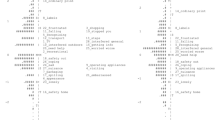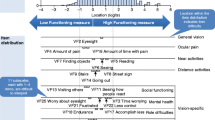Abstract
Purpose
To examine the psychometric characteristics of the World Health Organization Quality of Life instrument—modified Indian version (modified WHOQOL) and its subscales in adults with visual impairment (VI) using Rasch analysis.
Methods
Cross-sectional data were of people aged ≥40 years with VI (n = 1,333) who responded to the modified WHOQOL in the Andhra Pradesh Eye Disease Study, India. Rasch analysis was used to explore the instrument and its subscales for key indices such as measurement precision by person separation reliability, PSR (i.e., discrimination between strata of participants’ health-related QOL [HRQOL], recommended minimum value 0.8), unidimensionality (i.e., measurement of a single construct), and targeting (i.e., matching of item difficulty to participants’ HRQOL).
Results
Rasch-guided iterative approach including category re-organization to enable threshold ordering and item deletion to overcome multidimensionality resulted in a unidimensional 9-item WHOQOL and a 6-item level of independence (LOI) subscale with adequate PSR (0.81 and 0.82, respectively). Targeting was sub-optimal for both (−1.58 logits for WHOQOL and −2.55 logits for the subscale). Remaining subscales were dysfunctional.
Conclusions
The WHOQOL and LOI subscale can be improved and shortened, and the Rasch-revised versions are likely to assess the HROQL of VI patients best because of their brevity, reliability, and unidimensionality.


Similar content being viewed by others
References
WHOQOL Group. (1994). The development of the WHO quality of life assessment instrument (WHOQOL). In:J. Orley, W. Kukyen (Eds.), Quality of life assessment: International perspectives. Heidelberg: Springer.
WHOQOL Group. (1993). Study protocol for the World Health Organization project to develop a quality of life assessment instrument (WHOQOL). Quality of Life Research, 2, 153–159.
WHOQOL Group. (1994). Development of the WHOQOL: rationale and current status. International Journal of Mental Health, 23, 24–56.
Skevington, S. M., Lotfy, M., & O’Connell, K. A. (2004). The World Health Organization’s WHOQOL-BREF quality of life assessment: psychometric properties and results of the international field trial. A report from the WHOQOL group. Quality of Life Research, 13(2), 299–310.
Saxena, S., Chandiramani, K., & Bhargava, R. (1998). WHOQOL-Hindi: a questionnaire for assessing quality of life in health care settings in India. World Health Organization Quality of Life. National Medical Journal of India, 11(4), 160–165.
Bullinger, M., Anderson, R., Cella, D., & Aaronson, N. (1993). Developing and evaluating cross-cultural instruments from minimum requirements to optimal models. Quality of Life Research, 2(6), 451–459.
Dandona, R., Dandona, L., McCarty, C. A., & Rao, G. N. (2000). Adaptation of WHOQOL as health-related quality of life instrument to develop a vision-specific instrument. Indian Journal of Ophthalmology, 48(1), 65–70.
Nutheti, R., Shamanna, B. R., Nirmalan, P. K., Keeffe, J. E., Krishnaiah, S., Rao, G. N., et al. (2006). Impact of impaired vision and eye disease on quality of life in Andhra Pradesh. Investigative Ophthalmology & Visual Science, 47(11), 4742–4748.
Dandona, R., Dandona, L., Naduvilath, T. J., Nanda, A., & McCarty, C. A. (1997). Design of a population-based study of visual impairment in India: the Andhra Pradesh eye disease study. Indian Journal of Ophthalmology, 45, 251–257.
Lee K., Ashton M. C. (2007). Factor analysis in personality research. In: R. W. Robins, R. C. Fraley, R. F. Krueger (Eds.), Handbook of research methods in personality psychology (pp. 424–443). New York, NY: Guilford Press.
Gothwal, V. K., Wright, T. A., Lamoureux, E. L., & Pesudovs, K. (2009). Cataract symptom scale: clarifying measurement. British Journal of Ophthalmology, 93(12), 1652–1656.
Gothwal, V. K., Wright, T. A., Lamoureux, E. L., Lundstrom, M., & Pesudovs, K. (2009). Catquest questionnaire: re-validation in an Australian cataract population. Clinical & Experimental Ophthalmology, 37(8), 785–794.
DeVellis, R. F. (2006). Classical test theory. Medical Care, 44, S50–S59.
Hambleton R. K. (2000). Emergence of item response modeling in instrument development and data analysis. Medicine Care 38(9 Suppl), II60–II65.
Pesudovs, K. (2006). Patient-centred measurement in ophthalmology–a paradigm shift. BMC Ophthalmology, 6, 25.
Andrich, D. A. (1978). A rating scale formulation for ordered response categories. Psychometrika, 43, 561–573.
Bond, T. G., & Fox, C. M. (2001). Applying the Rasch model: fundamental measurement in the human sciences. London: Lawrence Erlbaum Associates.
Pallant, J. F., Miller, R. L., & Tennant, A. (2006). Evaluation of the Edinburgh Post natal Depression Scale using Rasch analysis. BMC Psychiatry, 6, 28.
Tennant, A., & Conaghan, P. G. (2007). The Rasch measurement model in rheumatology: what is it and why use it? When should it be applied, and what should one look for in a Rasch paper? Arthritis and Rheumatism, 57(8), 1358–1362.
Tennant, A., Penta, M., Tesio, L., Grimby, G., Thonnard, J. L., Slade, A., et al. (2004). Assessing and adjusting for cross-cultural validity of impairment and activity limitation scales through differential item functioning within the framework of the Rasch model: the PRO-ESOR project. Medical Care, 42(1 Suppl), I37–I48.
Norquist, J. M., Fitzpatrick, R., Dawson, J., & Jenkinson, C. (2004). Comparing alternative Rasch-based methods vs raw scores in measuring change in health. Medical Care, 42(1 Suppl), I25–I36.
Gothwal, V. K., Wright, T. A., Lamoureux, E. L., & Pesudovs, K. (2010). Activities of daily vision scale: what do the subscales measure? Investigative Ophthalmology & Visual Science, 51(2), 694–700.
Gothwal, V. K., Wright, T. A., Lamoureux, E. L., & Pesudovs, K. (2009). Rasch analysis of visual function and quality of life questionnaires. Optometry and Vision Science, 86(10), 1160–1168.
Gothwal, V. K., Wright, T. A., Lamoureux, E. L., & Pesudovs, K. (2009). Visual activities questionnaire: assessment of subscale validity for cataract surgery outcomes. Journal of Cataract and Refractive Surgery, 35(11), 1961–1969.
Gothwal, V. K., Wright, T. A., Lamoureux, E. L., & Pesudovs, K. (2010). Measuring outcomes of cataract surgery using the Visual Function Index-14. Journal of Cataract and Refractive Surgery, 36(7), 1181–1188.
Pesudovs, K., Gothwal, V. K., Wright, T., & Lamoureux, E. L. (2010). Remediating serious flaws in the National Eye Institute Visual Function Questionnaire. Journal of Cataract and Refractive Surgery, 36(5), 718–732.
Dandona, L., Dandona, R., Naduvilath, T. J., McCarty, C. A., Nanda, A., Srinivas, M., et al. (1998). Is current eye-care-policy focus almost exclusively on cataract adequate to deal with blindness in India? Lancet, 351(9112), 1312–1316.
Dandona, L., Dandona, R., Naduvilath, T. J., McCarty, C. A., Srinivas, M., Mandal, P., et al. (1999). Burden of moderate visual impairment in an urban population in southern India. Ophthalmology, 106(3), 497–504.
Dandona, L., Dandona, R., Srinivas, M., Giridhar, P., Vilas, K., Prasad, M. N., et al. (2001). Blindness in the Indian state of Andhra Pradesh. Investigative Ophthalmology & Visual Science, 42(5), 908–916.
Dandona, R., Dandona, L., Srinivas, M., Giridhar, P., Prasad, M. N., Vilas, K., et al. (2002). Moderate visual impairment in India: the Andhra Pradesh Eye Disease Study. British Journal of Ophthalmology, 86(4), 373–377.
Ferris, F. L., 3rd, Kassoff, A., Bresnick, G. H., & Bailey, I. (1982). New visual acuity charts for clinical research. American Journal of Ophthalmology, 94(1), 91–96.
Rasch, G. (1960). Probabilistic models for some intelligence and attainment tests. Copenhagen, Denmark: Institute of Educational Research.
Linacre, J. M. (2008). WINSTEPS Rasch measurement computer program. Chicago: Winsteps.com.
Wright, B. D., & Masters, G. N. (1982). Rating scale analysis. Chicago: MESA Press.
Gothwal, V. K., Wright, T. A., Lamoureux, E. L., & Pesudovs, K. (2009). Rasch analysis of the quality of life and vision function questionnaire. Optometry and Vision Science, 86(7), E836–E844.
Linacre, J. M. (2002). Optimizing rating scale category effectiveness. Journal of Applied Measurement, 3(1), 85–106.
Pesudovs, K., Wright, T. A., & Gothwal, V. K. (2010). Visual disability assessment: valid measurement of activity limitation and mobility in cataract patients. British Journal of Ophthalmology, 94(6), 777–781.
Wright B. D. (1996) Reasonable mean-square fit values. In: B. D. Wright, J. M. Linacre (Eds.), Rasch measurement transactions (p. 370). Chicago: MESA.
Linacre, J. M. (1998). Detecting multidimensionality: which residual data-type works best? Journal of Outcome Measurement, 2(3), 266–283.
Smith, E. V., Jr. (2002). Detecting and evaluating the impact of multidimensionality using item fit statistics and principal component analysis of residuals. Journal of Applied Measurement, 3(2), 205–231.
Linacre J. M. (2005).User’s guide to Winsteps. Chicago: MESA Press.
Wright, B. D., & Stone, M. H. (1979). Best test design. Chicago: MESA Press.
Mallinson, T., Stelmack, J., & Velozo, C. (2004). A comparison of the separation ratio and coefficient alpha in the creation of minimum item sets. Medical Care, 42(1 Suppl), I17–I24.
Mallinson, T. (2007). Why measurement matters for measuring patient vision outcomes. Optometry and Vision Science, 84(8), 675–682.
Pesudovs, K., Burr, J. M., & Elliott, D. B. (2007). The development, assessment and selection of questionnaires. Optometry and Vision Science, 84, 664–675.
Wright, B. D. (1996). Local dependency, correlations and principal components. Rasch Measurement Transactions, 10, 509–511.
Wright B. D. (1985). Additivity in psychological measurement. In: E. Roskam (Ed.), Measurement and personality assessment (pp. 101–112). Amsterdam: Elsevier Science.
Svensson, E. (2001). Guidelines to statistical evaluation of data from rating scales and questionnaires. Journal of Rehabilitation Medicine, 33, 47–48.
Schipper H., Clinch J., Olweny C. L. M. (1996) Quality of life studies: Definitions and conceptual issues. In: B. Spilker (Ed.), Quality of life and pharmacoeconomics in clinical trials (pp. 11–23). Philadelphia: Lippincott-Raven Press.
Rubin, G. S., Munoz, B., Bandeen-Roche, K., & West, S. K. (2000). Monocular versus binocular visual acuity as measures of vision impairment and predictors of visual disability. Investigative Ophthalmology & Visual Science, 41(11), 3327–3334.
West, S. K., Munoz, B., Rubin, G. S., Schein, O. D., Bandeen-Roche, K., Zeger, S., et al. (1997). Function and visual impairment in a population-based study of older adults. The SEE project. Salisbury Eye Evaluation. Investigative Ophthalmology & Visual Science, 38(1), 72–82.
Wang, J. J., Mitchell, P., Smith, W., Cumming, R. G., & Attebo, K. (1999). Impact of visual impairment on use of community support services by elderly persons: the Blue Mountains Eye Study. Investigative Ophthalmology & Visual Science, 40(1), 12–19.
Scott, I. U., Smiddy, W. E., Schiffman, J., Feuer, W. J., & Pappas, C. J. (1999). Quality of life of low-vision patients and the impact of low-vision services. American Journal of Ophthalmology, 128(1), 54–62.
Rovner, B. W., Zisselman, P. M., & Shmuely-Dulitzki, Y. (1996). Depression and disability in older people with impaired vision: a follow-up study. Journal of the American Geriatrics Society, 44(2), 181–184.
World Health Organization (1948) World Health Organization constitution. In: Basic documents. Geneva: World Health Organization.
Sloane M. E., Ball K., Owsley C., Bruni J. R., Roenker D. L. (1992) The visual activities questionnaire: Developing an instrument for assessing problems in everyday visual tasks. In: Nonivasive assessment of the visual system: 1992 (pp. 26–29). Technical Digest (Optical Society of America).
Andersen, E. B. (1977). Sufficient statistics and latent trait models. Psychometrika, 42, 69–81.
Acknowledgments
The authors thank the participants for their participation in the study; Lalit Dandona and Rakhi Dandona for design and execution of the APEDS; and Nagaraj V. Naidu, Kovai Vilas, Pyda Giridhar, and Mudigonda N. Prasad for administering the questionnaires and the entire APEDS team for conducting the study. This study was supported by the Hyderabad Eye Research Foundation, Hyderabad, India.
Conflict of interest
The authors have no personal financial interest in the development, production, or sale of any device discussed herein.
Author information
Authors and Affiliations
Corresponding author
Rights and permissions
About this article
Cite this article
Gothwal, V.K., Srinivas, M. & Rao, G.N. A new look at the WHOQOL as health-related quality of life instrument among visually impaired people using Rasch analysis. Qual Life Res 22, 839–851 (2013). https://doi.org/10.1007/s11136-012-0195-6
Accepted:
Published:
Issue Date:
DOI: https://doi.org/10.1007/s11136-012-0195-6




